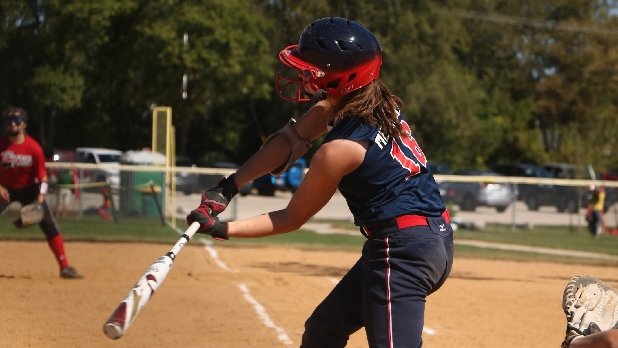Last Updated on August 13, 2023
Softball is a thrilling sport that needs skill, strategy, and quick reflexes to pitch the ball successfully.
The rise ball is the most challenging to hit among the pitches that a softball player can throw. However, although it is challenging, you can become a master at hitting a rise ball in softball.
So let’s know how to hit a rise ball in softball. First, look for any upward movement of the ball to identify if it’s a rise ball. If it is, then prepare yourself and swing your bat a little upward to hit. Do not swing lower; the ball will be slightly above the strike zone.
As a coach, I believe I know better how to train players and make them skilled at hitting different balls. Today, I will discuss my three-step formula to hit a rise ball in softball successfully.
Why Does the Pitcher Throw a Rise Ball?
The pitcher throws a rise ball to outwit the batter as it is quite challenging to hit the ball. Initially, the ball will look to be in the strike zone, but gradually it rises up, fooling the batter.
Hitting a rise ball is difficult for all types of softball players. I have seen many experienced top-class batters struggling to face the rise ball. That’s why this pitch is quite popular.
Although many batters seem to leave the rise ball, it’s not impossible. But first, you need to understand the mechanics of a rise ball to identify it and strategize your shot.
Understanding the Mechanics of a Rise Ball
The pitcher employs a specific grip and hand position to throw a rise ball. The grip usually involves placing the index and middle fingers close together across the seams of the ball. Pitching accuracy is vital for a rise ball.
Besides, the thumb is positioned underneath the ball for support. The rest of the fingers remain on the back or side of the ball.

The easiest way to identify a rise ball is the upward movement of the ball as it approaches the batter. The pitcher imparts a significant amount of backspin underneath the ball, making it rise.
At first, it appears to be on a similar trajectory as a fastball. This is where the pitcher fools the batter. But if you want to hit the ball, you must look for upward movement to identify it.
If you see it rising without any sign of going down, it’s a rise ball. Then you must prepare for it.
Read: How To Become A Better Slow Pitch Softball Hitter
Steps to Successfully Hit the Rise Ball in Softball
You can successfully hit the rise ball if you know the proper strategy and gain expertise. As a coach, I tell my players that to hit any ball, first identify the pitch early, then make your strategy & prepare yourself for the hit, and finally make the hit.
Here’s my three-step technique to successfully hit the rise ball in softball games:
Step 1: Recognizing the rise ball early in its trajectory
Most softball players need to recognize it early to hit the rise ball. They often swing the bat low and miss the ball. That is why my first suggestion is to recognize the ball first.
When the pitcher spins the ball mainly on the side instead of underneath the ball, it results in a poor rise ball. If you see there is not much rise or flattening, then it’s a poor one. A poor-rise ball will be easier to hit.
But if there is a sharp rise of the ball, then it’s a good rise ball. It will be pretty difficult to hit this one. First, identify whether it’s good or poor, then make your strategy.
Step 2: Appropriate balance and grip for approaching the pitch
When you know it’s a rise ball; you need to act accordingly. Although there will not be much time to change your position, as a good athlete, you should know to react quickly.
Your feet should be shoulder-width apart to prepare for hitting a rise ball. Your body weight should be evenly distributed between both legs. Besides, bend your knees a little bit for quick movement while hitting.
You can choose any grip style, such as the traditional knuckle grip or the overlapping V. The key here is to be comfortable with it. But try to avoid a hard grip as it can reduce the flexibility to swing and make a good hit.
This balance and gripping style are necessary for facing any good ball, including the rise ball. Hence, you can prepare like this even before the pitcher releases the ball.
Step 3: Timing and weight transfer for generating power to hit the rise ball
Proper timing and weight transfer are the most important parts of generating enough power and successfully hitting the rise ball. If you take too much time identifying the rise ball and preparing yourself, you can end up mishitting.
Swing the bat fast from behind to the front to hit the ball. As it’s a rise ball, do not swing low. Keep the bat a little bit high and swing sideways. Then hit the ball at an upward angle to make the best shot.
You need to keep in mind that the ball will be above the strike zone. Hence, you need to swing your bat in that direction. Do not just randomly swing at the strike zone.
While swinging the bat, shift your weight from the back foot to the front foot to generate enough power. Your front foot should be at a straight angle or line with your body head.
Also, keep your head in the same position while swinging and hitting the rise ball. You will obviously rotate a bit as you swing, but only move it a little, or you will lose balance.
Here’s a video demonstrating how to hit a rise ball:
Common Challenges You Will Face When Hitting the Rise Ball
Hitting a rise ball in softball is difficult due to various reasons. You must overcome these challenges to be an expert at hitting rise balls.

Here are the common challenges you may face while trying to hit a rise ball:
- Misjudging the pitch’s trajectory: Initially, the ball seems like any other ball, and that’s where the batter misjudges it. But you need to be careful and see if it is moving upward or curving like other balls.
- Swinging under the ball: When the batter fails to judge the pitch’s trajectory, they end up swinging underneath the ball. It often results in the ball going up in the air and being easy to catch.
- Wrong timing: Some batters also take a lot of time to judge the ball and make a strategy. It makes them slow and makes them swing the bat late. It can also cause mishit or out.
However, the good thing is that these situations are avoidable if you follow some simple tips.
Bonus Tips for Hitting the Rise Ball in Softball
First of all, you should follow the three-step formula I explained above to hit a rise ball. But initially, you may still need to do that.
Not to worry. Here are some tips that I believe will help you overcome the situation and face the rise ball more efficiently:
- Practice soft toss drills: Primarily, practice soft toss drills with your teammates or the coach. Ask the pitcher to toss the ball upward softly. It will improve your hand-eye coordination and make you more comfortable with the situation.
- Utilize batting tee drills: Also, do batting tee drills to ensure you do not hit underneath the ball. Set the tee at various heights to stimulate a rise ball and practice hitting solid to the ball.
- Face live pitching: Gradually move on to face live pitching. Work with the pitcher on your team or the pitcher coach. Facing the real rise ball will sharpen your skills faster.
- Analyze your performance: While facing the live pitch, take videos to analyze your performance. Find the mistakes and try to improve them. Also, mark your strength and utilize them to do better.
- Stay patient & do practice: Lastly, even if you fail to hit the rise ball, stay patient. Gaining expertise in hitting the rise ball takes a lot of practice and experience.
Want to improve your pitching? Here is a guide on Pitching for Beginners in Softball
FAQs:
1. Should I swing at every rise ball pitch I see?
No. It is optional to swing at every rise ball pitch. Swing when the ball is in your hitting zone. If it’s too high or fast, you can avoid the rise ball unless you must score to win.
2. Is the rise ball only thrown by advanced pitchers?
While it takes experienced pitchers to throw a good rise ball, it can come from pitchers of any level. You should always be prepared for a rise ball even if the pitcher is less experienced.
3. Can changing my bat size or weight help with hitting the rise ball?
Bat size or weight does not directly relate to hitting the rise ball. But it contributes to your ability to hit any ball in the game. Many believe a heavier bat can hit farther, but the fact is you also need enough strength to swing it.
4. What should I do if I keep swinging and missing the rise ball?
Take video footage of your missed shots and analyze what went wrong. Ask your coach to help you find your weaknesses. Then work on the weak areas to improve your ability to hit the rise ball.
My final opinion on hitting the rise ball
Never think that you need to hit every ball. A good player knows which ball she should hit and which one she should leave. Try to practice more and more to enhance your ability to hit the rise ball.
But never swing randomly just because you are batting. Check the ball’s movement when the pitcher throws and determine whether to strike or leave based on how good the rise ball is.
More Resources
How to Choose a Softball Glove?
How Are Softball Pants Supposed To Fit

Hello everyone. My name is Jason Butler, and I live in California, America. I was a professional AAA Minor League Baseball player. I lost my chance of playing MLB for injury issues, but I did not lose my love for baseball. I attended the coaching training program and am now working as a coach in a small school in San Diego.
I always love to share my experience and knowledge if that can help you. Play baseball, and stay fit.
